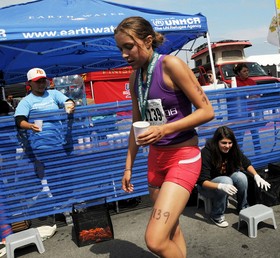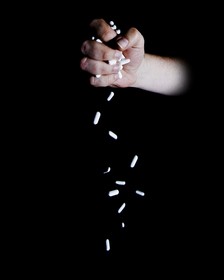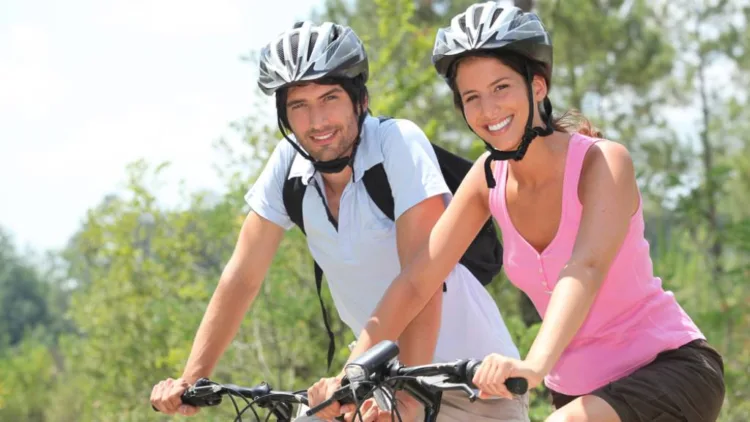 I’m over 40. In terms of triathlon training, swimming doesn’t bother me too much, but long bike rides and most runs take their toll.
I’m over 40. In terms of triathlon training, swimming doesn’t bother me too much, but long bike rides and most runs take their toll.
Pam knows when I’ve done a long run. I walk gingerly through the house, grimace in pain when getting out of a chair, and normally have difficulty sleeping that night. If I had a dollar for every bottle of ibuprofen I’ve used, I’d be set even if Wall Street collapsed…again.
I also got in the habit of taking my ibuprofen along to triathlon races. I remember once getting ready to pop a few during my bike-to-run transition, when another triathlete nearby said, “Are you sure you want to do that?”
His concern motivated me to do some research. What follows is a portion of what I learned.
Ibuprofen is an NSAID.
Non-steroidal anti-inflammatory drugs, usually abbreviated to NSAIDs (or NAIDs), are drugs known to reduce pain, fever, and inflammation.
The term “non-steroidal” is used to distinguish these drugs from steroids.
Some of the most common NSAIDs are Advil, Motrin, Aleve, ibuprofen, aspirin, and naproxen. NSAIDs are among the most common pain relief medicines in the world. Every day, more than 30 million Americans use them to soothe headaches, sprains, arthritis symptoms, and other aches and pains.
Some of the most well-known NSAID’s and their specific benefits include:
Aspirin
Aspirin is the most potent NSAID at preventing clotting, which is why patients are warned not to take it before a surgery. In addition, people suffering from symptoms of a heart attack have been advised to take an aspirin while waiting for the ambulance. The reason being that if the heart attack is being induced by a clot, the aspirin will thin the blood and potentially break up the clot.
Tylenol (Acetaminophen)
Tylenol is the least effective in anti- inflammatory properties but is still effective as a fever reducer. In addition, acetaminophen is renowned for being gentle on the stomach.
Ibuprofen
Ibuprofen is typically most effective in relieving aches and pains associated with muscle soreness, soft tissue injuries and joint pain (overuse injuries from training).
Triathletes and NSAIDs
For some triathletes, popping ibuprofen or other NSAIDs is as common as brushing your teeth.
Endurance training required for the sport of triathlon produces repetitive stress to muscles, tendons and tissues around joints and bones, resulting in pain and inflammation. For triathletes, pain and inflammation in the shoulder results from the motions involved with swimming, while lower extremity pain and inflammation result from motions involved with running and cycling.
The way NSAIDs work is by inhibiting an enzyme (a chemical that causes other chemical reactions to occur) called cyclooxygenase (sometimes referred to as COX). This enzyme is crucial for the inflammatory process to occur, and so by stopping the enzyme from working they stop inflammation.
What You Need To Know About NSAIDs
 The question of whether to use anti-inflammatories to “treat” overuse injuries has become a topic of great debate. The language itself can be misleading because anti-inflammatories don’t in fact “treat” or heal an overuse injury.
The question of whether to use anti-inflammatories to “treat” overuse injuries has become a topic of great debate. The language itself can be misleading because anti-inflammatories don’t in fact “treat” or heal an overuse injury.
If you’re accustomed to popping a few Advils to mask the pain of your IT band while you go out for your daily 10 mile run, you are likely doing more harm than good. Pain is your body’s way of telling you there’s something wrong, listen! Masking the pain with an NSAID is its own form of denial. NSAIDs manage the symptoms, but they don’t cure the underlying cause of the pain.
You need to address an ongoing problem by going to a good sports medicine doctor, physical therapist, or other highly qualified sports health professional who can properly access the problem and put you on a program that will promote true healing and prevent reoccurring injury. Many triathletes have turned a minor sprain into a tendon rupture from abusing NSAIDs, ignoring the pain, and continuing to run without addressing the underlying problem.
This said, taking an Advil to make yourself more comfortable and relieve pain induced by muscle soreness or injury is appropriate, even advisable, and will not delay the healing process. Proper use of NSAIDs can sometimes help speed recovery. The reasoning is that when we’re in less pain, we’re more comfortable so we are more relaxed and sleep better, which enables the healing process.
However, relying too heavily on NSAIDs (which means taking NSAIDs in high doses) for muscle soreness and injury is problematic.
The side effects of anti-inflammatories are typically broken down in 3 categories:
Common Side Effects
NSAIDs most commonly affect the gastrointestinal tract (stomach and intestines). Common side effects of long-term use of NSAIDs can include: indigestion, and stomach ulcer. Stomach ulcers can sometimes cause more serious complications, such as: gastrointestinal bleeding, anaemia (a condition where the blood cannot carry enough oxygen around your body), and gastrointestinal perforation (when a hole occurs in the wall of your stomach, or intestines).
Less Common Side Effects
Less commonly, NSAIDs can affect your heart and the rest of your circulatory system. Side effects can include: heart failure, heart attack, and raised blood pressure (hypertension). Although potentially very serious, these side effects are uncommon, and are most likely to affect someone who has an existing cardiovascular condition.
Rare Side Effects
In rare cases, NSAIDs may damage your liver, or kidneys. However, this only happens in a small number of cases and is most likely to affect those with existing liver or kidney conditions.
The R.I.C.E. Method For Pain Relief
In addition to the occasional use of NSAIDs, using the R.I.C.E. method to address microtrauma and injury caused by triathlon training is helpful. The method includes:
R = Rest – relative rest: cross training or reduced volume and/or intensity
I = Ice – apply ice for 20-30 minutes every 2-3 hrs for first 3 days
C = Compression – apply an elastic wrap to reduce swelling
E = Ele
vation – raise extremity above the level of the heart
In addition, recent research has found that gentle movement of the injured limb may help speed recovery by increasing blood flow to the area and preventing muscle atrophy. Thus R.I.C.E. has now become M.I.C.E., in which the “rest” has been replaced with “move” gently.
A Word About Ice…
 When it comes to the matter of inflammation, the use of ice directly over the injured area is an effective measure of minimizing pain, reducing inflammation, and perhaps preventing onset of muscle trauma, soreness, and injury.
When it comes to the matter of inflammation, the use of ice directly over the injured area is an effective measure of minimizing pain, reducing inflammation, and perhaps preventing onset of muscle trauma, soreness, and injury.
Many professional endurance athletes swear by “ice baths” and actually lower their entire body into a literal bath of ice after a hard training session. The basic idea is that cold reduces swelling and initially restricts blood flow, providing a natural compress on the microscopic tears in the tissue that are leaking blood into the traumatized area. Shortly, the body will recruit new blood to the cold area that flushes out metabolic wastes and lactic acid – byproducts of heavy muscle activity.
Timing Is An Issue
 The timing of NSAID use is also a crucial issue. Recent medical research shows that NSAIDs may be harmful to a triathlete’s kidney function if taken within 24 hours of an endurance event. The risk increases as the distance of the triathlon increases. For example, the risk of this occuring during an Ironman-distance triathlon would be higher than a Sprint-distance triathlon.
The timing of NSAID use is also a crucial issue. Recent medical research shows that NSAIDs may be harmful to a triathlete’s kidney function if taken within 24 hours of an endurance event. The risk increases as the distance of the triathlon increases. For example, the risk of this occuring during an Ironman-distance triathlon would be higher than a Sprint-distance triathlon.
NSAIDs are thought to increase the possibility of hyponatremia during endurance sports caused by decreasing blood flow to the kidneys and interfering with a hormone that helps the body retain salt. Therefore, it is recommended that on race day (specifically beginning midnight before your event) you do not use anything but Tylenol if needed until 6 hours after you have finished the race, and provided the following conditions:
-
You’re able to drink without any nausea or vomiting;
-
You’ve urinated once; and
-
You feel physically and mentally back to normal.
Then, a NSAID would be perfectly fine for preventing post-event muscle soreness.
Homeopathic Pain Management
With all this talk of NSAIDs, it is important to note that many triathletes choose to go the homeopathic route for anti-inflammatories and pain management.
-
One of the most common ingredients in homeopathic anti-inflammatory ointments and gels is Arnica.
-
Two popular homeopathic products are Traumeel and the Rescue Line of products from Peaceful Mountain.



